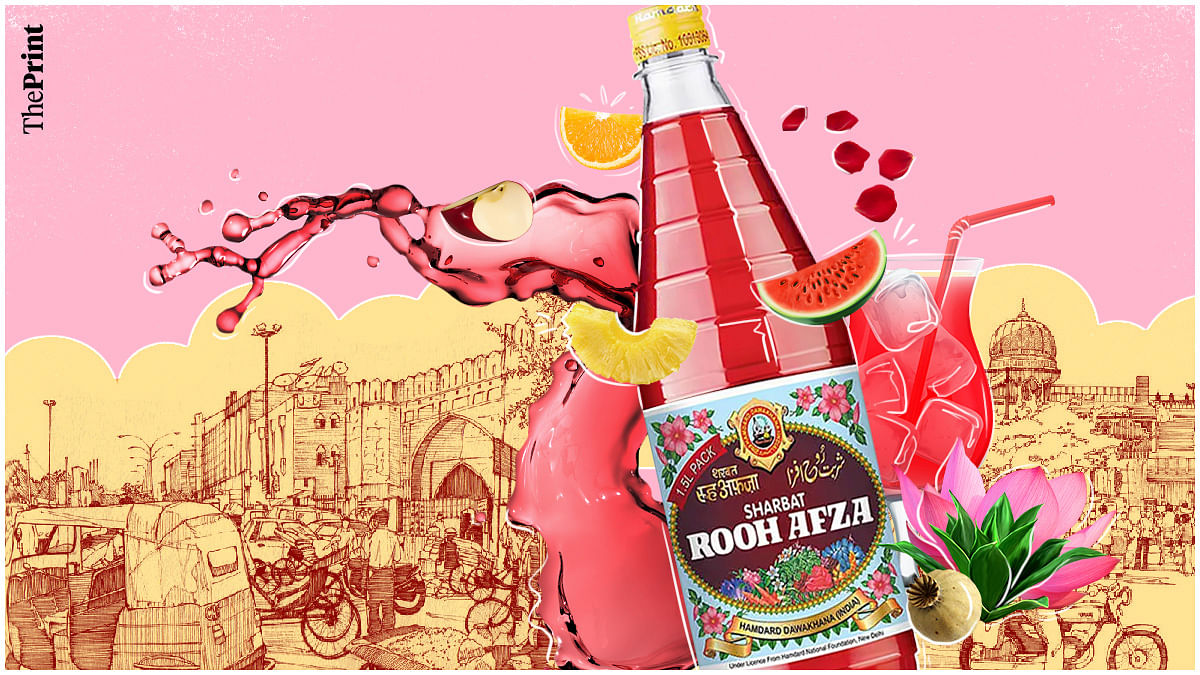by NUTAN MANMOHAN

Known for his flamboyant utterances, Oscar Wilde once said “Let me be surrounded by luxury! I can do without necessities.” This sentiment is true for many loved brands that may not really be essential in one’s daily life but exude a sense of comfort because they are charming.
Rooh Afza, a cooling squash with a luxuriant rose fragrance and attractive crimson shade, fits this description well. India has had a 117-year romance with this non-alcoholic syrup, which is diluted and drunk with milk or water and other concoctions.
Medicine to luxury
The story begins on an unusually hot summer day in 1907 in Delhi — the loo and dry heat, much like today, took a toll on people. Hakeem Hafeez Abdul Majeed, a unani or traditional medicine practitioner, combined various fruits, medicinal herbs, flowers, and condiments to create a medicinal beverage to hydrate and cool the body. The original concoction included fruits such as orange, watermelon, pineapple, and apple. Other ingredients included kewda, coriander, khus khus (poppy seeds), and flower extracts of rose and lotus. From the large cauldron containing the deep red syrup, Hakeem Majeed would serve his customers their portions, which they took in their own glass bottles and utensils.
Within a year, this concoction became so popular that Hakeem Majeed had to formalise his business. He named the drink ‘Rooh Afza’, meaning soul refresher. Choosing a simple glass bottle with five distinct rings around its tapering neck, the hakim hired a local printer from Old Delhi’s Hauz Qazi area to design an eye-catching red label for his brand. Rooh Afza was spelt in three languages – Hindi, English, and Urdu. And even today, nothing has changed.
Rooh Afza began to be produced on an industrial scale in Ghaziabad. Hakeem Majeed’s wife, Rabea Begum, used to assist her husband and supervised the whole production process. When the founder died in 1922, she and her two sons established the ‘Hamdard Trust’ and continued to manufacture Rooh Afza.
“Hamdard means someone who has empathy — a companion in pain. The trust was committed to using 85 per cent of its profits for charity. We continue to follow that motto,” says Hamid Ahmed, the great-grandson of Hakeem Majeed and the current CEO of Hamdard Laboratories.
Chuski, falooda, kulfi
Over the years, the beverage gathered a greater fan following. From a medicinal concoction, Rooh Afza became a luxury non-alcoholic sherbet served asa premier drink at festivals and weddings to esteemed guests. Across various kiosks in Old Delhi, Rooh Afza was blended in cold milk and consumed as a pre-meal appetiser. Generous amounts of syrup were drizzled on crushed ice and given to children as chuskior ice lollies. Splayed over translucent falooda or thick translucent vermicelli, it was served with kulfi to create a special flavour of handmade ice cream. “I believe it is nostalgia, family associations, and childhood memories that carried our brand forward in homes across India,” says Hamid Ahmed.
The second big shake-up happened during Partition. Hakeem Majeed’s elder son, Hakim Abdul Hameed, stayed in India to run the original Hamdard Trust while his brother, Hakim Mohammad Said, migrated to Pakistan and started producing Rooh Afza in Karachi.
The Print for more
